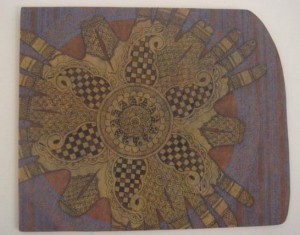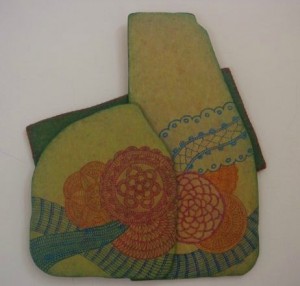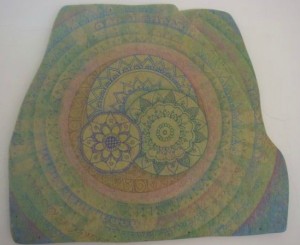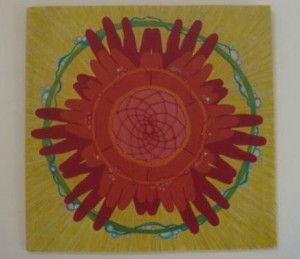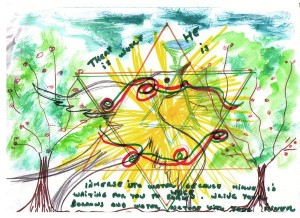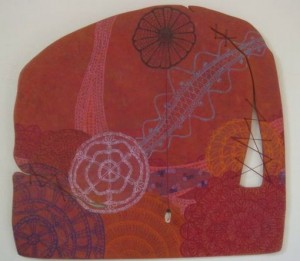Mandalas at the Mikveh
An Inclusive Mikveh in Israel
For the last three years, I have lived at Kibbutz Hannaton in Lower Galilee. My family was part of a group of eighteen families who joined the kibbutz in order to save it from bankruptcy and develop it into a haven for liberal, open Jewry in Galilee. Kibbutz Hannaton was founded as a classic socialist collective in the 1980’s by a group of Masorti (the Israeli version of the Conservative movement) Jews. But when only five families remained and the kibbutz was bankrupt, members were told that the land would be taken from them if they could not find eighteen new families to join the kibbutz and privatize it.
One thing that interested me about living on Hannaton was the fact that there was a mikveh on site that had become rundown over the years, but that was still being used for Masorti movement conversions. In Israel, mikvaot (ritual baths) are generally run by the Israeli Rabbinate, which does not recognize non-Orthodox conversions and therefore does not even allow such conversions to take place in their state mikvaot. They also forbid single women’s immersions out of fear women will consider the immersion a license to have pre-marital sex (since immersion changes the status of a woman from the state of tameh—ritually impure and sexually off limits—to tahor—ritually pure and sexually permitted); as well as those of brides who are being married by a non-Orthodox rabbi. At these mikvaot there is also a woman in charge who is an employee of the Rabbinate who insists on checking the woman’s body before and during the immersion, which some women find intrusive.
I had a dream of turning the Hannaton mikveh into a pluralist mikveh where anyone (man or woman, gay or straight, single or married, Orthodox or religiously liberal, Jew or non-Jew) who wants to immerse could do so, and where the terms and conditions of the immersion would be up to the one who is immersing. I also envisioned it as an educational mikveh where people would come to learn about mikveh as well as experience a mikveh immersion for the first time, and where people would come to immerse for a variety of rituals, not only the more traditional ones—for instance, life cycle rituals, transition rituals, healing rituals, etc. So I raised some money to make the place look warm and inviting and to turn it into a space appropriate for gathering and learning as well as bathing and immersing.
And that is how “Shmaya: A Ritual and Educational Mikveh in Galilee” was born. At Shmaya there is always something going on, whether it be a ritual immersion for purification, a pre-wedding immersion, a conversion, a transitional ritual immersion, a group meditation and immersion session, an adult workshop about mikveh, or an educational youth program. Moving life cycle events are a regular occurrence at Shmaya, as are life-changing religious experiences. But last month we decided to try something new: an art-immersion workshop at the mikveh.
A Mandala for the Mikveh
The idea germinated at a mandala workshop at artist and art therapist Linda Gollub Berger’s house at Hannaton. The word “mandala” is Sanskrit, and mandalas are most identified with Hinduism and Buddhism, but images similar to mandalas are actually a widespread tradition in various religions, including Judaism. A mandala is a circular depiction used to focus attention, establish a sacred space, and aid in meditation.
Mandalas are often symmetrical and balanced, but Linda’s mandala paintings are interestingly not balanced themselves. Still, they somehow evoke in the viewer balance and wholeness nonetheless for moments at a time. Like life, they are not orderly and neat, yet the challenge is to find moments of centeredness amidst the chaos—to find a way to connect to our spiritual center, our unique Godliness, despite the challenges life throws our way.
In Linda’s view, the Jewish equivalent to the mandala is the Shiviti, the traditional diagram found in many synagogues. Often shivitis depict a menorah with a circle sitting upon its arms, and (unlike mandalas), often they contain magical or Kabbalistic texts. They are intended to aid in kavvanah (intention) in prayer.
When I heard Linda speak about the mandala and the Shiviti, I immediately thought of the mikveh, because there is a strong tradition of writing kavanot (plural of kavvanah) for mikveh immersion. Why not write one’s intention not merely in words, but in the form of a mandala or Shiviti? I liked the idea of using mandala drawing as a way to spiritually prepare for mikveh immersion, since mandalas are often circular and mikveh is very much about marking life cycle transitions and celebrating the circle of life. Mikveh immersion is also often experienced as spiritually centering, similar to meditating on a mandala. When one immerses in the mikveh, one reconnects to the primordial waters of wholeness that existed before a dualistic world was created—in some deep way creating a moment of what it could feel like to return to the womb, where each human existed in that same feeling of pre-creation wholeness before being born into this world of duality, complexity, uncertainty, and imbalance.
So that is how Linda and I found ourselves one winter evening with a circle of women around a table with a single candle, drawing paper, and various drawing and painting implements.
Although this was a risky experiment—I never know when trying something like this for the first time if the participants will connect to what seems axiomatic to me—the results were beyond my expectations. Each woman present took this opportunity to create her own mandala, a circular depiction of her current spiritual state. The results were beautiful.
One woman had recently turned 70 years old and had an eighth grandchild, and the day of the workshop was the 8th anniversary of her move to Israel. She saw the workshop as an opportunity to mark these turning points with a mikveh immersion ritual. Often it’s traditional to immerse seven times, but this woman wondered if she should dunk one more time for her eighth anniversary and grandchild, when suddenly she had a vision of the number eight turning on its side and becoming the sign for infinity. That is when she reported that she connected to her spiritual core and felt its infinite potential. She felt immense joy to be alive and well and ready to take on whatever new experiences life had in store for her in her seventies. Her mandala had incorporated the number seven over and over in her design until the number eight appeared, mirroring her immersion experience.
Another woman had completed menopause and did a moving life transition ritual in the mikveh after drawing her mandala, which was a series of circles that she went over and over in a circular motion order to bring some order to what she referred to as her feeling of internal chaos.
Another talked about the feeling of imbalance and turmoil in her life as she tried to decide whether to remain in Israel where her aging parents live, or return to the U.S. where her children and grandchildren were now living; her mandala reflected the chaos she was feeling inside, although she said immersing in the mikveh did help calm and center her at least for the time she was inside its embracing waters. She said she emerged feeling more able to face this difficult decision.
Another young woman had moved to Israel only one year ago from the Boston area and was having a hard time adjusting. The thing she missed most about the U.S., she said, was places like Mayyim Hayyim, the community mikveh in Newton, Mass., which was where she immersed monthly before moving to Israel, and which was one of my inspirations when creating Shmaya. After she immersed, she said this was the first spiritual mikveh experience she had since moving to Israel. These were deeply powerful experiences.
“This is where HE is”
I will close by focusing on one mandala made that evening, by a woman named ElsaJana. ElsaJana had completed breast cancer treatments and was moving back to her native South America after living in Israel for a number of years, in order to return to family. We all heard her singing in the mikveh as we sat working on our mandalas and she immersed in private. Her mandala was a Star of David (composed of two triangles, one with its base down reaching to Heaven, and the other pointing downwards bringing the Divine Presence to earth) with a burst of yellow sun in its center, representing her hopes, and a large dove breaking through the borders of the Star of David, representing her pure and peaceful yet vivacious spirit. Here is how she explains it:
“I used the paper horizontally to simplify the space between up and down. I started from the center of the page and went from inside to the outside using colored markers. First of all, there were lines up and down in green and red, involving some hidden sun keys in the musical and harmonic scale of heart’s rhythm after immersion in the ritual bath. Not starting in circles or closed shapes wanted to mean opened lines around the world going and coming back as an Universal Circle, which not only include the painting but also the painter. Since that moment I stopped thinking to let feelings and emotions appear talking to me.
“Immediately I composed a big triangle with base down which made me feeling protective on going up. Then, I draw another triangle opposing the first and, there it was as many times in my pictures, the Magen David containing my hopes. Sensation that the triangle looking down was not so much protective as the other, I made close and around it another triangle in green. That was the instant when a sunset yellow explosion appeared in the middle of the Magen David, going out.
“Then, that explosion got me [thinking] of the heart beating in the picture as my inner heart. And therefore, I built a heart for the big Magen David which for my surprise was also a smaller Maguen David on the left made in green, sometimes in two lines and sometimes in three ones, to infuse more vigor reinforcing strengths.
“It was the time when a bird in big wings appeared flying up through light. Immediately I made two trees, one each side the Magen David, with large roots going from the one to the other. And I painted the foliage in two different watered colors. The trees were completed with some red points meaning fruits or flowers like honey from soul. And then, I let the sky enter also in watered blues and set up a Kiddush cup at the top of the Magen David Heart to thanks HIM for the creation and life.
“Soon appeared words in my fingers who wanted to be written and I wrote them down on the bottom of the page… Finally, as the coordinators asked us to finish and pay attention. And I received the impulse to write on the top and both sides of the small triangle formed on the top of the big original Magen David where the Kiddush cup stood up crowning the M. David’s heart, a little being inside, another little outside: “There is where HE is.”
According to psychologist David Fontana, the symbolic nature of the mandala can help one “to access progressively deeper levels of the unconscious, ultimately assisting the meditator to experience a mystical sense of oneness with the ultimate unity from which the cosmos in all its manifold forms arises.” Carl Jung saw the mandala as “a representation of the unconscious self,” and believed his paintings of mandalas enabled him to identify emotional disorders and work towards wholeness in personality. And in the Jewish context, the shiviti often contains a central element, symbolic of Shabbat, when humanity gets closest to Godliness, closest to that wholeness we all aspire to, that feeling of balance, of finding our spiritual center, the spark of God that is in each and every one of us. I sense these symbols in the mandalas created by these extraordinary women on that memorable evening, and on the mandalas now hanging at the mikveh, aiding women and men in their transitions to come.
![[the current issue of ZEEK]](../../image/2/100/0/5/uploads/leftistethicistgraphic-52842c6a.png)
- 5000 Pages of Zeek
- Founded in 2001, Zeek was the first Jewish online magazine, and we have over 5000 pages online to prove it, all available free of charge. Read more in the Archive.
More articles by
Rabbi Haviva Ner-David
More articles in
Faith and Practice
- To-Do List for the Social Justice Movement: Cultivate Compassion, Emphasize Connections & Mourn Losses (Don’t Just Celebrate Triumphs)
- Inside the Looking Glass: Writing My Way Through Two Very Different Jewish Journeys
- What Is Mine? Finding Humbleness, Not Entitlement, in Shmita
- Engaging With the Days of Awe: A Personal Writing Ritual in Five Questions
- The Internet Confessional Goes to the Goats


